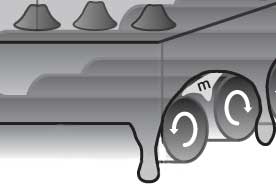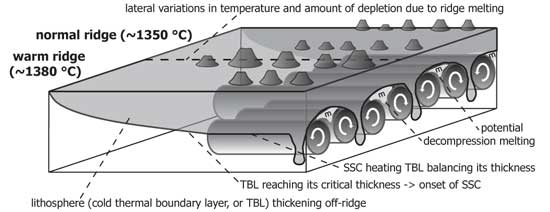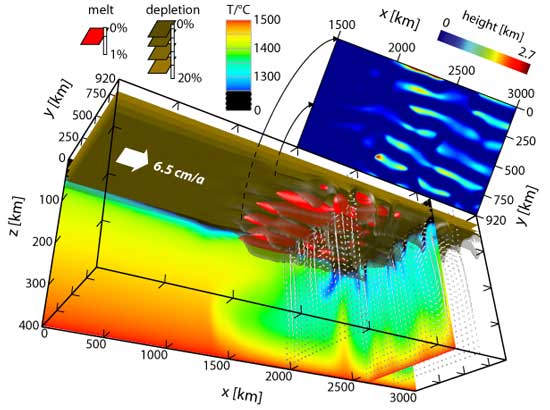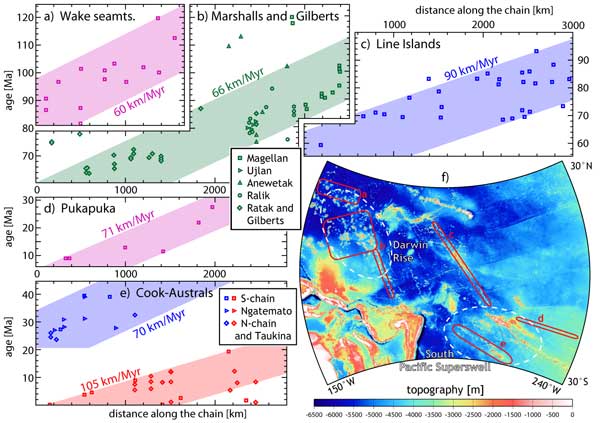 |
Non-hotspot volcano chains originating from small-scale sub-lithospheric convection |
M.
D. Ballmer1*, J.
van Hunen2,
G.
Ito3, P.
J. Tackley1 and T.
A. Bianco3
1Institute of
Geophysics, ETH Zürich, Zürich,
Switzerland
2Department of Earth Sciences, Durham
University, Durham, UK
3SOEST, University
of Hawaii at Manoa, Honolulu, HI, USA
*corresponding author: ballmer@hawaii.edu
Whereas plume theory successfully
predicts many observations at some volcano chains [Courtillot
et al., 2003], it is insufficient to explain the
whole spectrum of oceanic intraplate volcanism on Earth.
A mantle plume is assumed to be the geodynamic explanation
for a fixed hotspot. Many ridges, however, lack linear
age-distance relationships and an association with
an oceanic plateau as predicted by plume theory. On
the Pacific plate, prominent chains with voluminous
volcanism violate this prediction, such as the Cook-Australs,
Marshalls, Gilberts, and Line Islands. Thus, these
chains cannot have been formed by the Pacific plate
overriding stationary hotspots [Koppers et al.,
2003; Koppers
et al.,
2007; Davis et al., 2002; Bonneville
et al., 2006].
A mechanism that has often been invoked
to account for non-hotspot volcanic ridges is lithospheric
cracking. Cracks may be induced by tensile stresses
[Sandwell et al., 1995], by loading with volcanic
edifices [Hieronymus & Bercovici, 2000],
or by thermal contraction [Sandwell & Fialko,
2004; Gans et al., 2003]. Cracks are supposed
to control where and when volcanism occurs [Natland,
1980]. However, they do not provide an explanation
for magma generation itself. The cracking hypothesis
rather presumes a broad reservoir of pre-existing partial
melt that may be tapped. Such a layer of partial melt
in the asthenosphere was originally proposed to account
for anomalously low seismic-wave velocities [Anderson
and Sammis, 1970]. However, recent studies show
that partial melt is not required to explain seismic
observations [Faul & Jackson, 2005; Stixrude & Lithgow-Bertelloni,
2005; Priestley & McKenzie, 2006]. Moreover,
partial melting in the asthenosphere would tend to
increase seismic wave velocities due to dehydration
of the residue [Karato & Jung, 1998].
Since a reservoir of partial melt in the asthenosphere
is at odds with geophysical observations, we neglect
the lithospheric cracking hypothesis.
Another possible mechanism for intraplate
oceanic volcanism without linear age-distance relationships
is small-scale sublithospheric convection [SSC; Bonatti & Harrison,
1976; Haxby & Weissel, 1986; Buck & Parmentier,
1986; Marquart et al., 1999; Ballmer
et al.,
2007]. SSC spontaneously develops at the base of
mature oceanic lithosphere, whenever the cold thermal
boundary layer below the lithosphere exceeds a threshold
thickness. Thereafter, convection is a more efficient
heat transport mechanism than conduction. It self-organizes
as rolls aligned with plate-motion [Richter & Parsons,
1975], with parallel upwellings spaced 200-300 km apart
(Figure 1).

Figure 1: SSC develops in rolls
aligned with plate motion, as soon as the thermal
boundary layer exceeds a critical thickness. Its
onset is earlier adjacent to lateral density heterogeneities
and later for larger Tm or ηeff.
(from Ballmer
et al., 2007).
Whether and how much melting is generated from SSC
depends on the onset age of the SSC. The onset age
is most sensitive to:
- the effective viscosity in the asthenosphere ηeff,
and
- the amount of pre-existing lateral density heterogeneity
[Huang et al., 2005; Korenaga & Jordan,
2002; Dumoulin et al., 2005].
Low ηeff and
lateral heterogeneity both tend to trigger SSC beneath
younger seafloor. If SSC onsets beneath relatively
old and thick lithosphere, the rather small thermal
anomalies resulting (e.g., compared with a
plume) are unable to generate significant melting.
Higher mantle temperatures Tm also
enable SSC melting beneath thicker lithosphere, for
later onset ages (Figure 2).

Figure 2: Results of the 3D-numerical
models of Ballmer
et al. [2007].
Amount of volcanism vs. age of the underlying seafloor
for different model runs (varying the parameter Tm and ηeff).
Vertical axis is the total volumetric rate of melt
extraction in vertical (y-z) cross-section of our
model divided by the number of SSC cells. It represents
the average volume of melt extracted from a single
SSC cell per unit time and per km in the direction
of plate motion. Curves are shaded according to ηeff as
indicated in the scale above. Colors indicate different
reference temperatures. Numbers indicate heights
(in km) of volcanic edifices with a slope of 10°,
that could be created if all of the melt extracted
above an SSC upwelling accretes as chains of circular
volcanoes spaced 100 km apart. Viscosity predominantly
controls volcano height, whereas Tm controls
both the age of seafloor during magmatism and volcano
height.
SSC triggers melting by disrupting
the thermal and compositional stratification of the
uppermost mantle. The positive thermal anomalies in
SSC upwellings that result from advection of asthenospheric
mantle along the adiabat are usually insufficient to
trigger melting in a depleted harzburgite layer which
already experienced MOR melting. However, immediately
after its onset, SSC removes this depleted layer in
downgoing sheets and replaces it with fresh mantle
from below, allowing subsequent melting (Figure 3).
For larger Tm, removal of a thicker
buoyant depleted layer from more extensive MOR melting
is more difficult, and SSC therefore develops later
with the possibility of deeper melting (Figure 2).
The duration of volcanism due to SSC
is limited by secondary cooling of the asthenosphere.
Melting slowly ensues after the removal of the harzburgite
layer. Intrinsic positive density anomalies of partially
molten peridotite further drive decompression and melting
[Tackley & Stevenson, 1993; Raddick
et al., 2002; Hernlund et al., 2008].
Therefore, melt production and extraction (i.e.,
volcanism) successively increase to a maximum ~ 4 Ma
after their onset (Figure 2). However, SSC itself diminishes
temperatures in the asthenosphere, as it continues
to mix the bottom of the cold thermal boundary (Figure
3) into the asthenosphere. Thus, the duration of volcanism
is limited to ~ 8 Ma with a length-scale of the underlying
melting anomaly of ~ 1500 km (for fast Pacific plate-motion).
The ages along an associated volcano chain are not
predicted to be time-progressive. As the melting anomaly
is elongated (“hot line”) and not point-like,
the age relationships are predicted to be more complex
than a simple progression [Bonatti & Harrison,
1976; Ballmer
et al.,
2007; 2009a].

Figure 3: Isosurfaces of melt fraction
and depletion, and cross-sections of the temperature
and velocity field, for an example calculation (Tm =
1380°C and ηeff =
1.6 x 1019 Pa s). Lifted from the top
is a plan view of the thickness of melt accumulated
onto a plate moving over the box. The harzburgite
layer is partly removed in downgoning sheets. Hence,
partial melting emerges above SSC upwellings. Melting
is limited by secondary cooling of the asthenosphere
due to the SSC itself (greenish colors; figure is
from Ballmer
et al., 2007).
Such behaviour could explain key observations
at some, previously enigmatic, volcanic chains in the
Pacific. Figure 4 shows ages vs. distance along the
Marshalls, Gilberts, Lines, Cook-Australs, and Pukapuka
ridges. For the Marshalls and the Pukapuka ridges,
most samples fall into bands with a finite width of
1500 km and 1000 km, respectively (cf. shaded fields
in Fig. 4), as would be predicted for volcanism on
a plate moving over a “hot line” as caused
by SSC. For the Cook-Austral chain on the South Pacific
Superswell, volcanism has been attributed to at least
three [Bonneville et al., 2006], or even more
[McNutt et al., 1997] “plumelets”.
However, two different episodes of SSC-volcanism (the
younger of which maybe reactivated beneath older seafloor
by the South Pacific “Superplume” [e.g., McNutt,
1998]) provide an alternative explanation [Ballmer
et al., 2009a]. The overall age-progression of
at least one episode of SSC-volcanism at the Cook-Austral
Islands (and of the Pukapuka ridges) does not correspond
to absolute plate motion (cf., slopes of the fields
in Figs. 4d, 4e), something that may be explained by
the onset age of SSC systematically varying through
geological time (e.g., for systematically
decreasing Tm). For both the Cook-Austral
and the Marshall-Islands, the lateral spacings of the
individual (parallel) subchains are well consistent
with the the typical wavelength of SSC, while older
seafloor ages at the time of active volcanism (i.e.,
50-100 Ma) than predicted by our simple models for Tm ≤ 1410°C
are reconciled by accounting for a heterogeneous mantle
source with small fractions of fusible lithologies
such as enriched peridotite, and pyroxenite [Ballmer
el al., 2009b].

Figure 4: Ages collected at the
(a) Wake seamounts, the (b) Marshalls, the (c) Line
Islands, the (d) Pukapuka ridges, and the (e) Cook-Australs
plot within fields in age-distance space of width (a,
b, e) 1500 km, (c) 2000 km, and (d) 1000 km, respectively.
This behavior is consistent with volcanism formed on
the Pacific Plate overriding a quasi-stationary elongated
magma source (“hot line”). In order to avoid
introducing additional scattering, we take ages only
from a limited number of reliable sources [cf., Ballmer
et al., 2009a]. In (b) and (e) distances are
obtained by projecting the locations of the seamounts
of each of the 5 and 2 lineaments (cf. legends), respectively,
on top of each other (with a projection axis parallel
to the lineaments). Locations of the volcano chains
on the Pacific Plate are given in (f). (figure is taken
from Ballmer et al., 2009a). Click here or on figure
for enlargement.
The Line Islands are also reasonably
well explained by SSC. These volcanoes display two
events of quasi-synchronous volcanism that erupted
laterally over ~ 2000 km and on seafloor aged 30-55
Ma [Davis et al., 2002]. This range of seafloor
age is consistent with our models with Tm ~
1380-1410°C. Lateral density heterogeneity in the
asthenosphere beneath the Line Islands presumably triggered
SSC locally (during two distinct events). Since neighbouring
limbs of SSC away from the heterogeneity develop later,
volcanism evolved along a single lineament as observed
at the Line Islands. Local (and episodic) SSC implies
slower asthenospheric cooling, and may therefore explain
the larger length-scales of the melting anomaly (i.e.,
~ 2000 km) than predicted by our models.
Volcanism due to SSC requires either
a slightly lower ηeff or
a slightly higher Tm in
the asthenosphere than average. Smaller-than-average ηeff (or
lateral density heterogeneity) are needed for early
onset of SSC and volcanism on young seafloor without
the requisite of anomalously large Tm.
For chains evolving on middle-aged seafloor (e.g.,
the Marshalls and Cook-Australs), small excess temperatures
of the order of 50°C are sufficient to produce
large volumes of volcanism, whereas much larger thermal
anomalies (>>100°C) are required for significant
volcanism by the hotspot or lithospheric cracking mechanisms.
These volumes of melt are generated by overturning
the thermal and compositional stratification in the
uppermost mantle inherited at the MOR. Several other
ridges with poorly constrained geochronology potentially
originate from SSC as well.
References
-
Anderson, D. L., and C. Sammis
(1970), Partial melting in the upper mantle, Phys.
Earth Planet. Int., 3, 41-50.
-
-
Ballmer, M. D., J. van Hunen,
G. Ito, T. A. Bianco, and P. J. Tackley (2009a),
Intraplate volcanism with complex age-distance
patterns: a case for small-scale sublithospheric
convection, Geochem.
Geophys. Geosyst.,
10, doi:10.1029/2009gc002386
-
Ballmer, M. D., G. Ito, J. van Hunen, and P. J.
Tackley (2009b), Small-scale sublithospheric convection
reconciles geochemistry and geochronology of 'Superswell'
volcanism in the western and south Pacific, submitted
to Earth Planet. Sci. Lett.
-
Bonatti, E., and C. G. A. Harrison
(1976), Hot lines in Earth's mantle, Nature , 263,
402-404.
-
Bonneville, A., L. Dosso, and
A. Hildenbrand (2006), Temporal evolution and geochemical
variability of the South Pacific superplume activity, Earth
Planet. Sci. Lett., 244,
251-269.
-
Buck, W. R., and E. M. Parmentier
(1986), Convection beneath young oceanic lithosphere:
Implications for thermal structure and gravity, J.
Geophys. Res., 91, 1961-1974.
-
Courtillot, V., A. Davaille,
J. Besse, and J. Stock (2003), Three distinct types
of hotspots in the Earth's mantle, Earth Planet.
Sci. Lett., 205, 295-308.
-
Davis, A. S., L. B. Gray, D.
A. Clague, and J. R. Hein (2002), The Line Islands
revisited: New Ar-40/Ar-39 geochronologic evidence
for episodes of volcanism due to lithospheric extension, Geochem.
Geophys. Geosyst., 3, 1018,
doi:1010.1029/2001GC000190.
-
Dumoulin, C., M. P. Doin, D.
Arcay, and L. Fleitout (2005), Onset of small-scale
instabilities at the base of the lithosphere: scaling
laws and role of pre-existing lithospheric structures, Geophys.
J. Int., 160, 344-356.
-
Faul, U. H., and I. Jackson
(2005), The seismological signature of temperature
and grain size variations in the upper mantle Earth
Planet. Sci. Lett., 234,
119-134.
-
Gans, K. D., D. S. Wilson, and
K. C. Macdonald (2003), Pacific Plate gravity lineaments:
Diffuse extension or thermal contraction?, Geochem.
Geophys. Geosyst., 16, 1074,
doi: 1010.1029/2002GC000465.
-
Haxby, W. F., and J. K. Weissel
(1986), Evidence For Small-Scale Mantle Convection
From Seasat Altimeter Data, J. Geophys. Res., 91,
3507-3520.
-
Hernlund, J. W., P. J. Tackley,
and D. J. Stevenson (2008), Buoyant melting instabilities
beneath extending lithosphere: 1. Numerical models, J.
Geophys. Res., 113, ISI:000255077800004
-
Hieronymus, C. F., and D. Bercovici
(2000), Non-hotspot formation of volcanic chains:
control of tectonic and flexural stresses on magma
transport, Earth Planet. Sci. Lett., 181,
539-554.
-
Huang, X., Y. Xu, and S. Karato
(2005), Water content in the transition zone from
electrical conductivity of wadsleyite and ringwoodite, Nature , 434,
746-749.
-
Karato, S., and H. Jung (1998),
Water, partial melting and the origin of the seismic
low velocity and high attenuation zone in the upper
mantle, Earth Planet. Sci. Lett., 157,
. 193-207.
-
Koppers, A. A. P., H. Staudigel,
J. P. Morgan, and R. A. Duncan (2007), Nonlinear
Ar-40/Ar-39 age systematics along the Gilbert Ridge
and Tokelau Seamount Trail and the timing of the
Hawaii-Emperor Bend, Geochem. Geophys. Geosyst., 8,
doi:10.1029/2006GC001489.
-
-
-
Marquart, G., H. Schmeling,
and A. Braun (1999), Small-scale instabilities
below the cooling oceanic lithosphere, Geophys.
J. Int., 138, 655-666.
-
McNutt, M. K. (1998), Superswells, Rev.
Geophys., 36, 211-244.
-
McNutt, M. K., D. W. Caress, J. Reynolds, K. A.
Jordahl, and R. A. Duncan (1997), Failure of plume
theory to explain midplate volcanism in the southern
Austral islands, Nature, 389, 479-482
-
Natland, J. H. (1980), The progression
of volcanism in the Samoan linear volcanic chain, Am.
J. Sci., 280, 709-735.
-
Priestley, K., and D. McKenzie
(2006), The thermal structure of the lithosphere
from shear wave velocities, Earth Planet. Sci.
Lett., 244, 285-301.
-
-
Richter, F. M., and B. Parsons
(1975), On the interaction of two scales of convection
in the mantle, J. Geophys. Res., 80,
2529-2541.
-
Sandwell, D., and Y. Fialko
(2004), Warping and cracking of the Pacific plate
by thermal contraction, J. Geophys. Res., 109,
B10411, doi:10410.11029/12004JB003091.
-
Sandwell, D. T., E. L. Winterer,
J. Mammerickx, R. A. R. A. Duncan, M. A. Lynch,
D. A. Levitt, and C. L. Johnson (1995), Evidence
for diffuse extension of the Pacific plate from
Pukapuka ridges and cross-grain gravity lineations, J.
Geophys. Res., 100, 15087-15100.
-
Stixrude, L., and C. Lithgow-Bertelloni
(2005), Mineralogy and elasticity of the oceanic
upper mantle: Origin of the low-velocity zone, J.
Geophys. Res., 110, ISI:000227876300002.
-
Tackley, P. J., and D. J. Stevenson
(1993), A mechanism for spontaneous self-perpetuating
volcanism on the terrestrial planets, in Flow
and Creep in the Solar System: Observations, Modeling
and Theory, edited by D. B. Stone and S. K.
Runcorn, pp. 307-322, Kluwer.
last updated 24th
November, 2009
|
